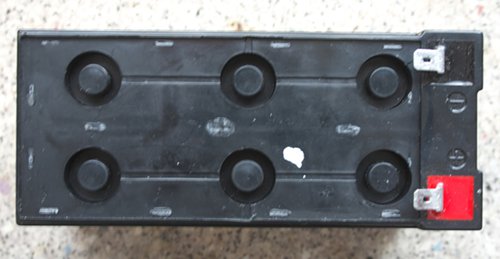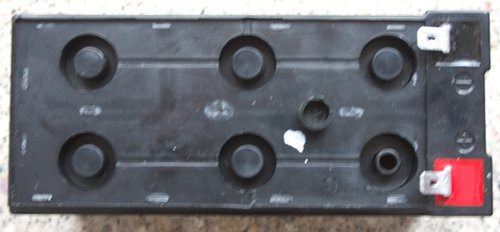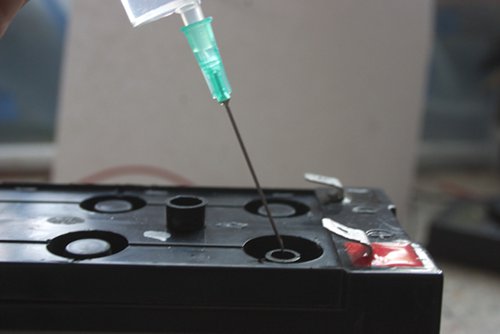UPS battery capacity recovery
The overwhelming majority of us use such an extremely useful device as an uninterruptible power supply. Food quality is not perfect everywhere, and just the smallest power problems can sometimes be expensive. Data loss is always unpleasant, and sometimes just fatal. The device was purchased, installed under the table, connected and the owner is in full confidence that in any case during a power outage, he will have time to properly complete the work, and maybe make a backup on the USB flash drive. As time goes on, the bespereboynik periodically makes itself felt - as a real watchdog, he gives a voice at the slightest deviations in the parameters of the power supply network. The owner is calm and all is well. But one day the interruption still happens and this time the UPS does not just give a voice and immediately switches from battery to network, this time the lights are turned off for a long time. We quietly copy files (after all, we have about 15 minutes in stock, no less), and here the uninterrupted power supply starts squeaking quite often and everything turns off. How so? After all, the bespereboynik was supposed to protect us from such situations, and he only gave us false confidence in our security! Why did it happen?
It's all about the batteries, from which our bespereboynik and feeds all our hardware when the external network is disconnected. But these batteries, alas, are not eternal, they degrade, their capacity decreases, and with it the battery life. Up to zero. Unfortunately, this process is often not controlled by anyone, the owner is confident that he is protected, but at this time the battery is no longer quite a battery, and so is a dummy.
What to do, what to do and where to run?
')
Why batteries are degrading? There are many reasons. Sulfation of the plates comes from intensive use, active substances are peeling off from overloads, and so on. In the UPS there is an unattended battery, but it still has electrolyte and this water-based electrolyte. Being constantly in the buffer mode, in the slow recharging mode, the water gradually evaporates and the electrolyte no longer fulfills its functions. The battery becomes unusable. How can this be avoided? To avoid this, you can use the correct mechanisms for charging the battery, controlling its characteristics, but all this is beyond our control - this is the lot of manufacturers of UPS.
It so happened that the Internet in my places is only wireless, for its operation a frightening antenna is installed on the roof, and its length is minimized to reduce signal loss in the cable. The server, which then distributes the Internet (another server and switch) - installed in the attic. For this small bundle need uninterrupted power. Even without taking into account the loss of data - to run to load the server at the slightest sneeze (and here they happen often) - there is little pleasure. Uninterrupted operation should be and preferably more. I bought a bespereboynik for 1100VA, not a new one (the new one is more expensive than those servers) and of course I did not rely on batteries - they are often well-worn. Well bought and bought. Put, everything seems to be okay. In the UPS control panel, they talked to me vigorously about almost an hour of battery life (there was a load of about 70 VA). I decided to check it out. I turned off the power and after about two minutes everything went off safely. Batteries "dead". Just the case with a false defense. There is nothing to do, you need to buy new batteries. I put backup batteries (it so happened that there is an electric bike and they are inactive), 12VA each. And the dead family came down.
I heard that the electrolyte in UPS batteries often simply dries out. What is not sulphation, not chipping plates is the cause of death of the UPS batteries, namely the drying of the electrolyte. Attempt, as they say, is not torture. Batteries are still on the release, and craving for picking did not give a chance. For the experiments I needed:
- Distilled water (in no case, NOT electrolyte!). Sold in the auto shop.
- A syringe, better with a needle - with a needle is easier to dose. Sold in the pharmacy.
- Knife for picking, stronger.
- Scotch for assembly (for aesthetes, of course ONLY blue duct tape must be!).
- Torch.

On the battery is glued lid that closes the banks. I neatly faked her with a knife (for picking). I had to walk in a circle - it was glued in several places.

Under the lid - banks, covered with rubber caps. These caps are probably needed to release water vapor, hydrogen and other things that can create excessive pressure in the bank when the battery is running. Such a nipple, which releases gas out, but does not let anything inside.
Caps are not glued, just took them off, prying with a knife.

Under the caps, if you look inside the jar - nothing interesting. Perfectly. For peeking need a flashlight.
I took a syringe, poured distilled water into it (Mainly without dirt. So that everything was clean!) And poured a cube of water into each jar.

The water was safely absorbed, almost instantly. I repeated it again. Then again, 5 or 7, I do not remember. Water should not tumble in the bank, but it should not “take” the water of the bank either. It is better to shine a flashlight and look. The main thing is not to pour.
After pouring water, I covered the cans with rubber caps and set the battery to charge. A charged separately, a large charger, but I think it is not necessary - you can charge it just in a bespereboinik. If the batteries are discharged below 10V, then they cannot be charged in this way, there is information that such batteries can also be “swung”, but for this you need to supply a high voltage (about 35V to 12V battery) at the initial stages with current control. I did not try, I can not say anything concrete. I can not recommend this method either.
The first point - if you overflowed water - it will return from under the cover. It should be collected with a syringe and poured into the sewer.
The second point - if you covered the jars with lids, then in the process of charging, the pressure in the jar rises a little and the lids will fly around the room with a characteristic chip. It's fun, but only once. I checked twice - the second time is not fun. I covered the covers with my own plastic cover, and put a load on it.
After charging, I slightly discharged the batteries with a car "carrying", about half an hour, measured the residual voltage, estimated the capacity. Charged again and again discharged.
I did the same thing with the second battery - their pair in the uninterrupted power supply. After all, I taped off the otkryyryannye tape, put the batteries in place.
The results are as follows:

In 10 minutes with a load of 110VA, the batteries were discharged to 79 percent. The battery life varied somewhat, at the end of the software spoke of almost 29 minutes + 10 already past, almost 40 minutes came out. I am satisfied with this state of affairs. It is enough to go and start the generator. When will I have it :). And on the way, and tea brew. And drink it.
If we proceed from 79% - this is 21% in 10 minutes or 47 minutes of battery life. Somewhere around what software promises.
Another calculation option is the total capacity of batteries 12V * 7Ah * 2pcs = 168 Watts / hour. This is the ideal. With a load of 110W, the charge should last for 1.5 hours. But in reality, even on new batteries, there will not be such a working time - the discharge current is too large and the output capacity will be lower. It is difficult to say for sure how much the capacity has been restored, but it is very likely that up to 80 percent of the nominal. In my opinion, it’s not bad at all for one syringe, distillate can and an hour of time.
The moral of this story is:
- Check periodically battery life. Pig they can put you in the most unpleasant moment.
- At your own risk, even battered batteries can be restored with little blood. But no, you always have time to buy new ones.
It's all about the batteries, from which our bespereboynik and feeds all our hardware when the external network is disconnected. But these batteries, alas, are not eternal, they degrade, their capacity decreases, and with it the battery life. Up to zero. Unfortunately, this process is often not controlled by anyone, the owner is confident that he is protected, but at this time the battery is no longer quite a battery, and so is a dummy.
What to do, what to do and where to run?
')
Why batteries are degrading? There are many reasons. Sulfation of the plates comes from intensive use, active substances are peeling off from overloads, and so on. In the UPS there is an unattended battery, but it still has electrolyte and this water-based electrolyte. Being constantly in the buffer mode, in the slow recharging mode, the water gradually evaporates and the electrolyte no longer fulfills its functions. The battery becomes unusable. How can this be avoided? To avoid this, you can use the correct mechanisms for charging the battery, controlling its characteristics, but all this is beyond our control - this is the lot of manufacturers of UPS.
It so happened that the Internet in my places is only wireless, for its operation a frightening antenna is installed on the roof, and its length is minimized to reduce signal loss in the cable. The server, which then distributes the Internet (another server and switch) - installed in the attic. For this small bundle need uninterrupted power. Even without taking into account the loss of data - to run to load the server at the slightest sneeze (and here they happen often) - there is little pleasure. Uninterrupted operation should be and preferably more. I bought a bespereboynik for 1100VA, not a new one (the new one is more expensive than those servers) and of course I did not rely on batteries - they are often well-worn. Well bought and bought. Put, everything seems to be okay. In the UPS control panel, they talked to me vigorously about almost an hour of battery life (there was a load of about 70 VA). I decided to check it out. I turned off the power and after about two minutes everything went off safely. Batteries "dead". Just the case with a false defense. There is nothing to do, you need to buy new batteries. I put backup batteries (it so happened that there is an electric bike and they are inactive), 12VA each. And the dead family came down.
I heard that the electrolyte in UPS batteries often simply dries out. What is not sulphation, not chipping plates is the cause of death of the UPS batteries, namely the drying of the electrolyte. Attempt, as they say, is not torture. Batteries are still on the release, and craving for picking did not give a chance. For the experiments I needed:
- Distilled water (in no case, NOT electrolyte!). Sold in the auto shop.
- A syringe, better with a needle - with a needle is easier to dose. Sold in the pharmacy.
- Knife for picking, stronger.
- Scotch for assembly (for aesthetes, of course ONLY blue duct tape must be!).
- Torch.

On the battery is glued lid that closes the banks. I neatly faked her with a knife (for picking). I had to walk in a circle - it was glued in several places.

Under the lid - banks, covered with rubber caps. These caps are probably needed to release water vapor, hydrogen and other things that can create excessive pressure in the bank when the battery is running. Such a nipple, which releases gas out, but does not let anything inside.
Caps are not glued, just took them off, prying with a knife.

Under the caps, if you look inside the jar - nothing interesting. Perfectly. For peeking need a flashlight.
I took a syringe, poured distilled water into it (Mainly without dirt. So that everything was clean!) And poured a cube of water into each jar.

The water was safely absorbed, almost instantly. I repeated it again. Then again, 5 or 7, I do not remember. Water should not tumble in the bank, but it should not “take” the water of the bank either. It is better to shine a flashlight and look. The main thing is not to pour.
After pouring water, I covered the cans with rubber caps and set the battery to charge. A charged separately, a large charger, but I think it is not necessary - you can charge it just in a bespereboinik. If the batteries are discharged below 10V, then they cannot be charged in this way, there is information that such batteries can also be “swung”, but for this you need to supply a high voltage (about 35V to 12V battery) at the initial stages with current control. I did not try, I can not say anything concrete. I can not recommend this method either.
The first point - if you overflowed water - it will return from under the cover. It should be collected with a syringe and poured into the sewer.
The second point - if you covered the jars with lids, then in the process of charging, the pressure in the jar rises a little and the lids will fly around the room with a characteristic chip. It's fun, but only once. I checked twice - the second time is not fun. I covered the covers with my own plastic cover, and put a load on it.
After charging, I slightly discharged the batteries with a car "carrying", about half an hour, measured the residual voltage, estimated the capacity. Charged again and again discharged.
I did the same thing with the second battery - their pair in the uninterrupted power supply. After all, I taped off the otkryyryannye tape, put the batteries in place.
The results are as follows:

In 10 minutes with a load of 110VA, the batteries were discharged to 79 percent. The battery life varied somewhat, at the end of the software spoke of almost 29 minutes + 10 already past, almost 40 minutes came out. I am satisfied with this state of affairs. It is enough to go and start the generator. When will I have it :). And on the way, and tea brew. And drink it.
If we proceed from 79% - this is 21% in 10 minutes or 47 minutes of battery life. Somewhere around what software promises.
Another calculation option is the total capacity of batteries 12V * 7Ah * 2pcs = 168 Watts / hour. This is the ideal. With a load of 110W, the charge should last for 1.5 hours. But in reality, even on new batteries, there will not be such a working time - the discharge current is too large and the output capacity will be lower. It is difficult to say for sure how much the capacity has been restored, but it is very likely that up to 80 percent of the nominal. In my opinion, it’s not bad at all for one syringe, distillate can and an hour of time.
The moral of this story is:
- Check periodically battery life. Pig they can put you in the most unpleasant moment.
- At your own risk, even battered batteries can be restored with little blood. But no, you always have time to buy new ones.
Source: https://habr.com/ru/post/138510/
All Articles